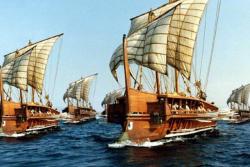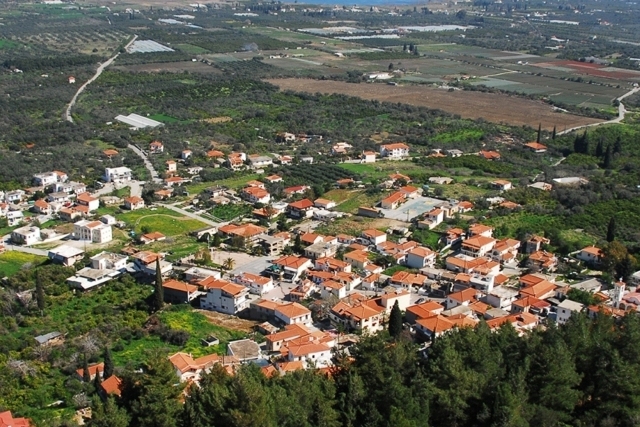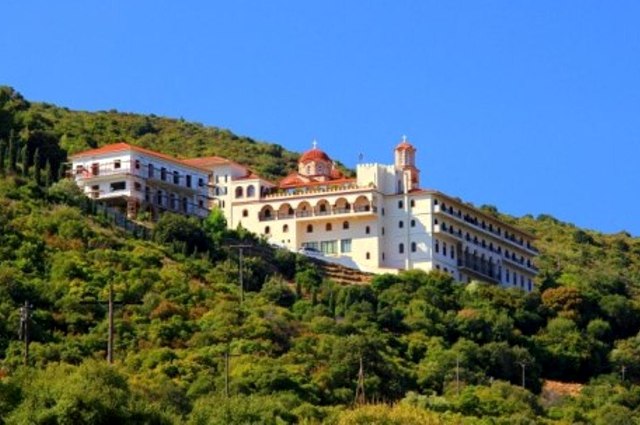Trizina
TRIZINA - Distance from Ermioni: 50 kms/1 hour
Trizina (Ancient Troezen) is located approximately 8kms West of Galatas, where the road turns away from the sea, towards the mountain village. A further 1.5kms to the West of the village, you will find the ruined city of Ancient Troezen. Trizina is famous in Greek history due to the united Third Hellenic National Assembly being held in the village during the Greek War of Independence against the Ottoman Empire 1821-1829. Following the dissolved Assemblies at Epidavros (Piada), Ermioni (Kastri) and Aegina, the united Assemby reconvened in Trizina (Damalas) from 19th March until 5th May 1827, which adopted a new constitution, elected Ioannis Kapodistrias as Governor of Greece and voted for establishing Nafplio as the future capital of Greece and seat of parliament and government. A marble monument located in the village square commemorates this important historical event.
Ancient Troezen was one of the earliest cult centres of Poseidon. The city was also called Poseidonia. Plutarch, the philosopher and writer tells us that this was the birthplace of Theseus, who was the great hero of the ancient Greeks. When Theseus was a young boy and Heracles stayed as a guest in the city, he armed himself with an axe and attacked Heracles thinking he was a lion, as he was wearing a lion-skin. Many years later, when Theseus helped Heracles defeat the Amazons and take the magic girdle of their queen Hippolyte, Heracles rewarded him by giving him the daughter of Ares in marriage, the Amazon called Antiope. Together they had a son called Hippolytus, who lived and ruled in Ancient Troezen. Hippolytus' tomb was housed in Troezen's most ancient temple, but this temple was destroyed by the severe earthquakes that followed the eruption of the volcano on Methana in 283 BC.
 The Troezenians took part in the epic Trojan War, 1194 -1184 BC, and much later during the second Persian invasion in 480 BC, the Greek fleet assembled at Troezen prior to sailing for Salamis. During this invasion, all the women and children of Athens were transferred to Troezen for safety, whilst the men fought and won the great sea battle at Salamis. A year later, in 479 BC, Troezen and Methana sent 200 hoplite warriors to fight the Persian invaders at the Battle of Plataea. Although Troezen had always been allied to Argos and Athens, the Troezenians allied themselves with Sparta during the Peloponnesian War, resulting in Athens sacking the ancient city of Troezen in 430 BC.
The Troezenians took part in the epic Trojan War, 1194 -1184 BC, and much later during the second Persian invasion in 480 BC, the Greek fleet assembled at Troezen prior to sailing for Salamis. During this invasion, all the women and children of Athens were transferred to Troezen for safety, whilst the men fought and won the great sea battle at Salamis. A year later, in 479 BC, Troezen and Methana sent 200 hoplite warriors to fight the Persian invaders at the Battle of Plataea. Although Troezen had always been allied to Argos and Athens, the Troezenians allied themselves with Sparta during the Peloponnesian War, resulting in Athens sacking the ancient city of Troezen in 430 BC.
During the Byzantine period, in the 9th century AD, Troezen was renamed Damalas, named after a wealthy official to the Byzantine Emperor Leon the Wise. Later, during the Frankish occupation of Corinth in 1204, Damalas fell into their hands. After the fall of Constantinople to the Ottoman Turks in 1453, Damalas was ceded to the Venetians who controlled the city until 1531. Excavations of Troezen were carried out in the 1890's by the French School of Archaeology, and the German Archaeological Institute in 1932. Ancient Troezen is not on the usual tourist trail, but a visit to the site is recommended, as the site is 'off-the-beaten-track' and you will probably be the only one there.
The modern village of Trizina and Ancient Troezen are an ideal place for those who love nature, hiking, cycling and exploring the surrounding mountains, the gorge at Devil's Bridge (Diabologefyros) and bathing in the small 'lagoons' of the gorge. From the village's mountainside position, the Methana peninsula, the coastal town of Galatas and island of Poros are visible in the distance.
Arriving at the small mountain village of Trizina, continue to the main square (plateia) which is at the centre of the village. The village tavernas and cafes offer the visitors home-made food and cool refreshing drinks with a warm welcome. For visiting Ancient Troezen, continue your journey on the road above the square and turn right at the traditional pottery workshop. After travelling for approximately 600 metres, you will reach a divide in the road which has all the direction signs next to the Stone of Theseus.
At this junction, the road to the left will bring you to the arched Temple of the Muses and the stone Tower of Diateichisma, also known as the Tower of Damalas and the Palace of Theseus. The tower was originally built during the 5th century BC, and became a Macedonian-Hellenistic fortress during the age of Alexander the Great, which was later enlarged during the Byzantine-Frankish era. After a 20 minute walk further along the narrow track, you will reach Devil's Bridge (Diavologefiro), an area which has wonderful scenic views, and is an ideal place to have a picnic, next to the trickling mountain stream surrounded by what feels like an ancient 'enchanted forest'.
The road to the right will eventually bring you to the Archaeological site of Ancient Troezen after approximately 1km. Direction signs will guide you to the site. Leave your car by the entrance gate and continue by foot through the ancient city. You will see the foundation stones of the Temple of Theseus, the Temple of Hippolytus and the medieval church remains of Panaghia Episkopi. Admission to the site: Free
It is worth calling in to the modern village of Trizina as alongside the main square there are a couple of tavernas and cafes offering traditional food and drinks. If you continue up the main street, after passing the village church of Aghios Leonidas (the patron saint of Trizina who lived in the ancient city in the 3rd century AD) there is an authentic working pottery craft shop on the corner of the road junction. You will also see that high on the Aderes mountainside, overlooking Trizina, there is the beautiful Monastery of the Annunciation of the Virgin Mary. The Monastery was established as recently as 1976 with about 14 resident monks, attracting many Orthodox pilgrims every year.
The mountain village community of Trizina consists of two settlements, Trizina and Aghios Georgios, which have approximately 800 inhabitants and belong to the present-day Municipality of Trizina-Methana, with headquarters in the nearby coastal town of Galatas.

